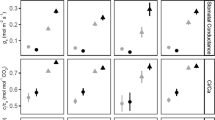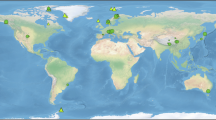Abstract
Projected warmer and drier climates are expected to impact heavily on plant diversity in Mediterranean-climate ecosystems, but experimental investigations of sensitivity and adaptive capacity are needed to better understand species responses. Here, we examine the effects of warming and drying on growth and allocation in seedlings from populations of two co-occurring Banksia shrub species from south-west Western Australia. We hypothesised that the species would show ecological divergence in functional traits reflecting niche differentiation. We expected to see tolerance to warming and drought correlated with position of the population on a climate gradient. We predicted that populations at the warmer/drier end of the gradient would show greater homeostasis of growth and allocation patterns in response to experimental treatment. Seedlings of the two species differed in leaf and allocation traits and in responses to experimental warming and drying. B. coccinea had smaller leaves with higher specific leaf area, and accumulated less overall biomass compared to B. baxteri when grown under cooler conditions. Under warmer conditions, B. coccinea could maintain growth, whereas B. baxteri suffered significant decline in biomass accumulation. Under water deficit conditions, both species showed significant reductions in leaf mass and area. Under combined warmer/drier conditions B. baxteri forfeited height growth and biomass and increased leaf allocation. The results support our hypothesis that seedlings of B. baxteri and B. coccinea are divergent in key functional traits and their sensitivity to warming and drying. However, we found no evidence for inter-population variation in traits being associated with position on a climate gradient.




Similar content being viewed by others
References
Adler PB, Fajardo A, Kleinhesselink AR, Kraft NJB (2013) Trait-based tests of coexistence mechanisms. Ecol Lett 16:1294–1306
Allen HD (2003) Response of past and present Mediterranean ecosystems to environmental change. Prog Phys Geogr 27:359–377
Balaguer L, Martínez-Ferri E, Valladares F, Pérez-Corona ME, Baquedano FJ, Castillo FJ, Manrique E (2001) Population divergence in the plasticity of the response of Quercus coccifera to the light environment. Funct Ecol 15:124–135
Bates B, Frederiksen C, Wormworth J (2012) Western Australia’s weather and climate: A synthesis of Indian Ocean climate initiative stage 3 research. CSIRO and BoM, Australia
Cabral JS, Jeltsch F, Thuiller W, Higgins S, Midgley GF, Rebelo AG, Rouget M, Schurr FM (2013) Impacts of past habitat loss and future climate change on the range dynamics of South African Proteaceae. Divers Distrib 19:363–376
Chesson P (2000) Mechanisms of maintenance of species diversity. Ann Rev Ecol Sys 31:343–366
Cochrane JA (2014) Among-population variation in seed and leaf traits: implications for Western Australian Banksia R.Br. (Proteaceae) in the context of climate change. Dissertation, Australian National University
Cochrane A, Hoyle GL, Yates CJ, Wood J, Nicotra AB (2014a) Warming delays and decreases seedling emergence in a Mediterranean ecosystem. Oikos. doi:10.1111/oik.01359
Cochrane A, Hoyle GL, Yates CJ, Wood J, Nicotra AB (2014b) Predicting the impact of warming temperatures on seed germination in multiple populations of Western Australian Banksia (Proteaceae) species. Seed Sci Res 24:195–205
Cornelissen JHC, Lavorel S et al (2003) A handbook of protocols for standardised and easy measurement of plant functional traits worldwide. Aust J Bot 51:335–380
Cunningham SA, Summerhayes B, Westoby M (1999) Evolutionary divergences in leaf structure and chemistry, comparing rainfall and soil nutrient gradients. Ecol Monogr 69:569–588
De Frenne P, Graae BJ et al (2011) An intraspecific application of the leaf-height-seed ecology strategy scheme to forest herbs along a latitudinal gradient. Ecography 34:132–140
Fitzpatrick MC, Gove AD, Sanders NJ, Dunn RR (2008) Climate change, plant migration, and range collapse in a global biodiversity hotspot: the Banksia (Proteaceae) of Western Australia. Glob Change Biol 14:1337–1352
Funk JL, Vitousek PM (2007) Resource-use efficiency and plant invasion in low-resource systems. Nature 446:1079–1081
Grime JP (1977) Evidence for the existence of three primary strategies in plants and its relevance to ecological and evolutionary theory. Am Nat 111:1169–1194
Hampe A, Petit RJ (2005) Conserving biodiversity under climate change: the rear edge matters. Ecol Lett 8:461–467
Jump AS, Peñuelas J (2005) Running to stand still: adaptation and the response of plants to rapid climate change. Ecol Lett 8:1010–1020
Klausmeyer KR, Shaw MR (2009) Climate change, habitat loss, protected areas and the climate adaptation potential of species in Mediterranean ecosystems worldwide. PLoS ONE 4:e6392
Lamont BB, Groom PK, Cowling RM (2002) High leaf mass per area of related species assemblages may reflect low rainfall and carbon isotope discrimination rather than low phosphorus and nitrogen concentrations. Funct Ecol 16:403–412
Lamont B, Enright N, Witkowski E, Groeneveld J (2007) Conservation biology of banksias: insights from natural history to simulation modelling. Aust J Bot 55:280–292
McGill BJ, Enquist BJ, Weiher E, Westoby M (2006) Rebuilding community ecology from functional traits. Trends Ecol Evol 21:178–185
Molina-Montenegro MA, Naya DE (2012) Latitudinal patterns in phenotypic plasticity and fitness-related traits: assessing the Climatic Variability Hypothesis (CVH) with an invasive plant species. PloS 7:e47620
Nicotra AB, Cosgrove MJ, Cowling A, Schlichting CD, Jones CS (2008) Leaf shape linked to photosynthetic rates and temperature optima in South African Pelargonium species. Oecologia 154:625–635
Nicotra AB, Atkin OK, Bonser SP, Davidson AM, Finnegan EJ, Mathesius U, Poot P, Purugganan MD, Richards CL, Valladares F, van Kleunen M (2010) Plant phenotypic plasticity in a changing climate. Trends Plant Sci 15:684–692
Pigliucci M (2001) Phenotypic plasticity: beyond nature and nurture. Johns Hopkins University Press, Baltimore
Poorter H, Niklas KJ, Reich PB, Oleksyn J, Poot P, Mommer L (2012) Biomass allocation to leaves, stems and roots: meta-analyses of interspecific variation and environmental control. New Phytol 193:30–50
Rasband WS (1997–2012) ImageJ, http://imagej.nih.gov/ij. U. S. National Institutes of Health, Bethesda, Maryland
Reich P, Ellsworth D, Walters M, Vose J, Gresham C, Volin J, Bowman W (1999) Generality of leaf trait relationships: a test across six biomes. Ecology 80:1955–1969
Reyer C, Leuzinger S et al (2012) A plant’s perspective of extremes: terrestrial plant responses to changing climatic variability. Glob Change Biol 19:75–89
Richter S, Kipfer T, Wohlgemuth T, Calderón Guerrero C, Ghazoul J, Moser B (2012) Phenotypic plasticity facilitates resistance to climate change in a highly variable environment. Oecologia 169:269–279
Roff DA (1992) The evolution of life histories: theory and analysis. Chapman and Hall, London
Rustad LE (2008) The response of terrestrial ecosystems to global climate change: towards an integrated approach. Sci Total Environ 404:222–235
Sardans J, Penuelas J, Estiarte M (2006) Warming and drought alter soil phosphatase activity and soil P availability in a Mediterranean shrubland. Plant Soil 289:227–238
Silvertown J (2004) Plant coexistence and the niche. Trends Ecol Evol 19:605–611
Talmon Y, Sternberg M, Grunzweig JM (2011) Impact of rainfall manipulations and biotic controls on soil respiration in Mediterranean and desert ecosystems along an aridity gradient. Glob Change Biol 17:1108–1118
Thompson RM, Beardall J, Beringer J, Grace M, Sardina P (2013) Means and extremes: building variability into community-level climate change experiments. Ecol Lett 16:799–806
Vasques A, Chirino E, Vilagrosa A, Vallejo VR, Keizer JJ (2013) The role of seed provenance in the early development of Arbutus unedo seedlings under contrasting watering conditions. Environ Exp Bot 96:11–19
Vicente-Serrano SM, Zouber A, Lasanta T, Pueyo Y (2012) Dryness is accelerating degradation of vulnerable shrublands in semiarid Mediterranean environments. Ecol Monogr 82:407–428
Violle C, Jiang L (2009) Towards a trait-based quantification of species niche. J Plant Ecol 2:87–93
Violle C, Navas M-L, Vile D, Kazakou E, Fortunel C, Hummel I, Garnier E (2007) Let the concept of trait be functional! Oikos 116:882–892
Vsn I (2011) GenStat for Windows 15th Edition, 15th edn. V International, Hemel Hampstead
Walck JL, Hidayati SN, Dixon KW, Thompson KEN, Poschlod P (2011) Climate change and plant regeneration from seed. Glob Change Biol 17:2145–2161
Wright IJ, Reich PB, Westoby M (2001) Strategy shifts in leaf physiology, structure and nutrient content between species of high- and low-rainfall and high- and low-nutrient habitats. Funct Ecol 15:423–434
Yates CJ, McNeill A, Elith J, Midgley GF (2010) Assessing the impacts of climate change and land transformation on Banksia in the South West Australian Floristic Region. Divers Distrib 16:187–201
Acknowledgments
We are grateful to members of the Nicotra lab group for assistance in the glasshouse and with dripper calibration. We thank Meisha Holloway-Philips for suggestions on a previous draft and also two anonymous reviewers for their useful comments on an earlier version of the manuscript.
Author information
Authors and Affiliations
Corresponding author
Electronic supplementary material
Below is the link to the electronic supplementary material.
Rights and permissions
About this article
Cite this article
Cochrane, A., Hoyle, G.L., Yates, C.J. et al. The phenotypic response of co-occurring Banksia species to warming and drying. Plant Ecol 216, 27–39 (2015). https://doi.org/10.1007/s11258-014-0414-z
Received:
Accepted:
Published:
Issue Date:
DOI: https://doi.org/10.1007/s11258-014-0414-z




